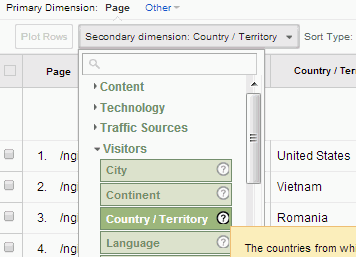Mastering Secondary Dimension in Google Analytics: A Full Guide
Mastering Secondary Dimension in Google Analytics: A Full Guide
Blog Article
Enhance Your Data Analysis Making Use Of Second Dimension in Google Analytics
Checking out the capacities of secondary measurements in Google Analytics opens up a realm of possibilities for refining information evaluation. By layering additional dimensions onto main data collections, an even more complex story arises, dropping light on user interactions and performance indicators.
Comprehending Second Measurements
In the realm of data evaluation, a critical aspect to understanding is the concept of second measurements and their relevance in drawing out deeper understandings from Google Analytics reports. Secondary measurements in Google Analytics describe extra specifications that can be contributed to the primary dimension, enabling a much more comprehensive evaluation of information. By integrating secondary dimensions, analysts can section and filter information to uncover patterns, patterns, and relationships that might not appear when checking out the data in its entirety. These secondary measurements can provide context and a much more detailed understanding of user actions, website traffic resources, and various other crucial metrics tracked by Google Analytics.

Advantages of Making Use Of Second Dimensions
When evaluating data in Google Analytics, the utilization of additional dimensions provides vital understandings right into user habits and efficiency metrics. By adding a second dimension to your primary information, you can delve much deeper right into the qualities of your website site visitors and their communications. Among the key benefits of making use of additional dimensions is the capacity to segment and compare information more effectively. This division allows you to understand exactly how different variables, such as demographics or web traffic sources, influence customer behavior and conversions (Secondary Dimension in Google Analytics).
In addition, additional dimensions help in identifying patterns and connections that may not be instantly noticeable when considering the data alone. This much deeper degree of evaluation can discover useful details that can assist marketing strategies, site optimization, and total organization choices. Additionally, secondary dimensions enhance the context of your main information, giving an extra thorough sight of user involvement and efficiency metrics. In general, using secondary measurements in Google Analytics can significantly improve the depth and quality of your data evaluation, leading to even more informed decision-making and enhanced results.
Exactly How to Include Additional Dimensions
By including additional measurements in Google Analytics, individuals can get pop over here deeper insights into their data evaluation process, permitting for more detailed evaluation of individual actions and efficiency metrics. Adding secondary dimensions is a straightforward procedure that can dramatically boost the depth of analysis. When in the record, situate the "Additional measurement" tab over the information table.
Studying Information With Second Measurements
Utilizing secondary dimensions in data evaluation gives a much more thorough understanding of customer habits and efficiency metrics. By including a second measurement to your key data established in Google Analytics, you can dive much deeper into the characteristics of your site visitors and their interactions. Combining the main dimension of 'source/medium' with the second measurement of 'landing web page' can expose which certain pages are drawing in web traffic from different resources, assisting you enhance these web pages for much better involvement.

Basically, assessing information with additional dimensions encourages you to obtain useful understandings right into user habits, recognize trends, and make informed decisions to enhance the efficiency of your digital properties.
Best Practices for Secondary Dimensions
In data analysis, incorporating secondary measurements properly can considerably boost the depth of understandings originated from metrics and customer actions patterns. When using additional measurements in Google Analytics or any other logical tool, it is critical to stick to ideal techniques to guarantee the accuracy and significance of the data analysis.
One key best method is to carefully choose additional measurements that complement the primary dimension being examined. Picking second dimensions that supply extra context or more segmentation can offer a much more extensive understanding of the data. It is also vital to stay clear of overcomplicating the evaluation by consisting of a lot of second measurements, which might result in complication or dilution of insights.
Furthermore, it is suggested to experiment with various combinations of additional and primary measurements to reveal new relationships and fads. Routinely improving the option my review here and evaluating of secondary measurements based on the certain objectives of the evaluation can lead to even more actionable understandings. By following these finest practices, data experts can utilize additional dimensions properly to enhance the overall data analysis procedure and decision-making capabilities.

Conclusion
In conclusion, incorporating second measurements in Google Analytics is essential for a detailed data analysis technique. By leveraging additional dimensions alongside primary ones, marketers and experts can reveal useful insights and relationships that can notify decision-making and optimize digital advertising and marketing strategies. Comprehending how to successfully utilize second measurements and complying with ideal practices will certainly allow specialists to remove purposeful information and enhance their total efficiency metrics.
Secondary dimensions in Google Analytics refer to added parameters that can be added to the main measurement, allowing for a much more in-depth evaluation of information. By incorporating secondary dimensions, experts can segment and filter data to uncover patterns, patterns, and correlations that might not be evident when looking at the data as a whole. Combining the key dimension of 'source/medium' with the second measurement of 'landing page' can reveal which details web pages are attracting traffic from various resources, helping you optimize these web pages for better engagement.
One secret ideal technique is to very carefully choose secondary dimensions that complement the key measurement being assessed. By complying with these best practices, information analysts can utilize secondary measurements successfully to boost the overall information evaluation process and decision-making capacities.
Report this page